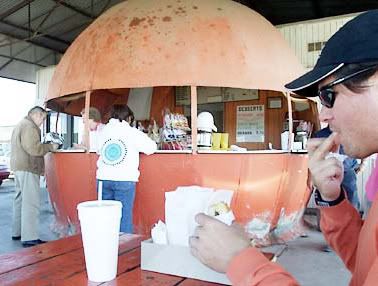(Basic Blocking and Tackling – promoted by jsw)
Cross posted on The Progressive Connection
 On Highway 99, near Chowchilla, stands a vacant metal building with a canopy that shelters a large orange sphere.
On Highway 99, near Chowchilla, stands a vacant metal building with a canopy that shelters a large orange sphere.
In the land before time, before there was McDonald’s or Burger King, there was Mammoth Orange, and its smaller relative, Giant Orange. These quintessential fast food joints, shaped like a citrus fruit and painted a violent shade of orange, served hamburgers and orange juice all up and down California’s Central Valley.
There were hundreds of them, landmarks of popular culture — and now there is just one left, the Mammoth Orange, on the east side of Highway 99 near the turnoff for Highway 152. Its days are numbered.
Progress is coming to this stretch of 99, one of the last bits of old four-lane highway with local access roads.
The old highway is being turned into a full-scale freeway. The crucial difference is that a freeway has limited access — drivers can’t enter or exit except on special on- and off-ramps. That means there’s no room on a freeway for roadside joints, like the Mammoth Orange.
The Mammoth Orange lost its battle earlier this year. Cut off from customers because of its poor access, the last-of-its-kind business weakened and then finally failed.
But the Mammoth Orange struck me as an apt, if peculiar, metaphor for California Democratic Party politics. You see, I have this image of the CDP as the new Highway 99 freeway. The Mammoth Orange is, of course, the grassroots…
Much like Hwy. 99 has what the Mammoth Orange needs (customers), the CDP has much of what the grassroots is desperately seeking. As promised in its 58-County Strategy, the CDP has the ability to offer both financial and logistical support in registering voters; it has materials and technological tools that it can make available; it has finance expertise it can share; it has liability insurance it can provide; and it has communications and research capability that it can deploy on behalf of Democrats.
But for the grassroots, much like the Mammoth Orange, the access provided by key connectors is critical to their success. With its 58-County Strategy, the CDP made the decision, for better or worse, to rely on the county Central Committees to deliver its services to the grassroots. In some counties with high-functioning Central Committees, this is a good plan. But in many, many other counties with dysfunctional Central Committees, it’s a lot like having a Mammoth Orange with no off-ramps.
So what’s to be done?
Well, the CDP unveiled some of its new plans at last weekend’s Central California Democratic Convention in Fresno. It’s my understanding that more details will be fleshed out at this weekend’s E-Board meeting in the OC (check out the Rural Caucus). In an attempt to strengthen the connectors that link the CDP to the grassroots, the Party will be meeting with every Central Committee to develop unique strategic plans for each county. Individualized goals will be fixed, timetables will be set, and benchmarks will be established which each Central Committee will be expected to meet.
Here are the guidelines set out by the CDP for the Central Committees:
Party Business:
- Regular monthly meetings, Executive Board meetings, and Standing Committee Meetings
- Full membership (either through election or appointment), alternate selection and associate memberships encouraged. Alternate and associate memberships to be aimed at diversifying the membership to reflect county demographics to the greatest extent possible
- Regular communications to members, Regional Directors and the CDP
- Formalized endorsement process
- Chartering and re-chartering process for clubs and encouraging club participation in the formal local party structure
Finance/Budget:
- Year round budget for all activities
- Establish fundraising goals with diverse methods of sustaining funding
Electoral Strategies/Voter Contact:
- Short and long term field plans: voter registration goals and targets, walk programs, key races, coordinated campaign development (coalition building with stakeholders)
- Using the CDP’s Online Campaign Center voter file to maintain and build data from cycle-to-cycle
Volunteer Recruitment and Management:
- Use of the Volunteer Management Database — to track, monitor and manage volunteers from within their county or those from outside who have indicated an interest in working in their county
- Trainings — Campaign Skills, Treasurer’s and others, as needed
Visibility and Outreach:
- Advertising events
- Sponsoring and speaking at affiliated events
- Earned media/Rapid Response team development
- Current and viable websites for each central committee
- Commitment to notify the CDP in a timely manner of changes in local party officers, chartered clubs — as well as upcoming events, so that the CDP website contains the most current information
Candidate Recruitment:
- Candidate training for Congressional, Senate and Assembly races
- Candidate training for down-ticket, non-partisan races
- Working with labor and other allied groups for non-partisan seats
- Elected official outreach; incumbent relations
Now, of all these guidelines, apparently only two will be optional: the use of the CDP’s Online Campaign Center voter file and the use of the Volunteer Management Database. Our Central Committees will be expected to fulfill all of the other duties listed above. Maybe, just maybe, these new and improved connectors will be just the shot-in-the-arm the grassroots has been hoping for.
